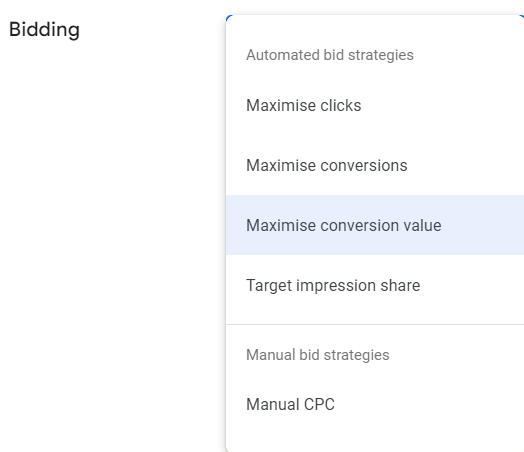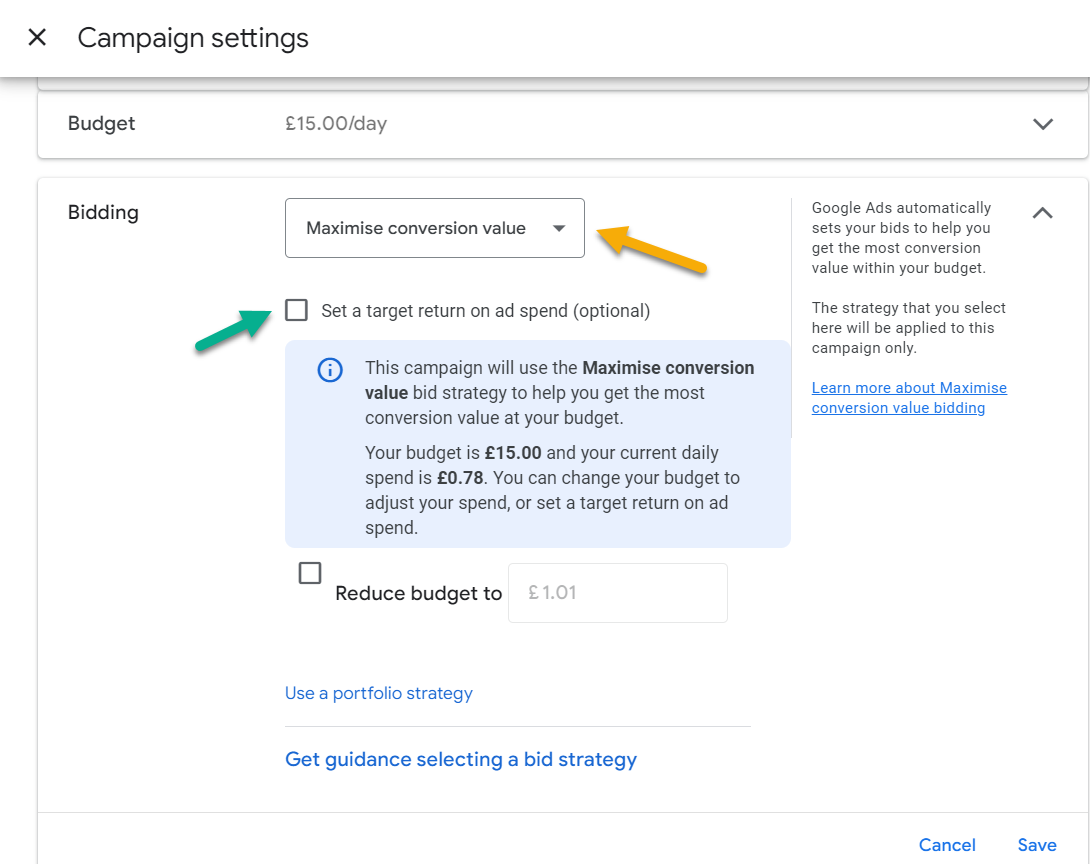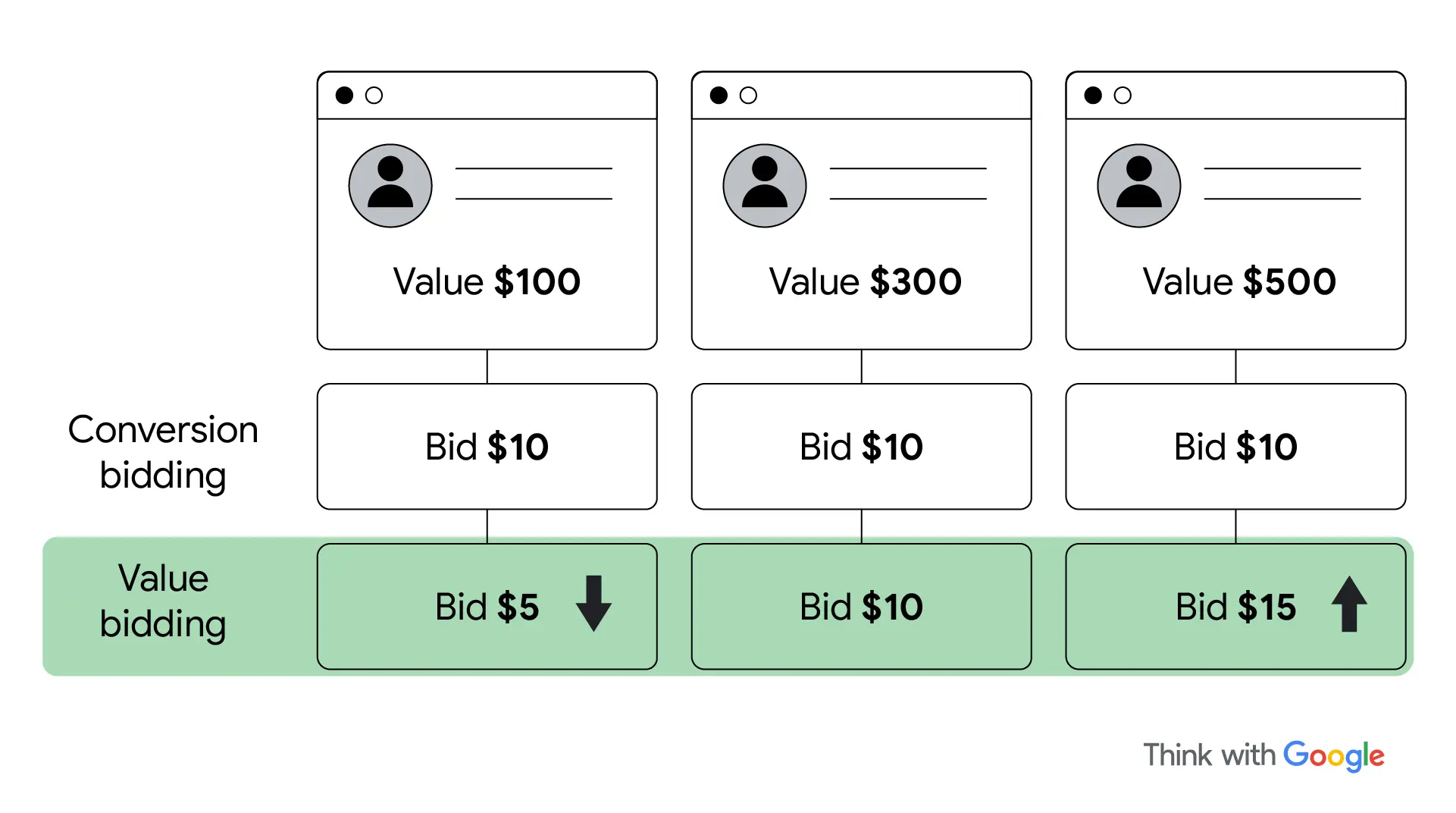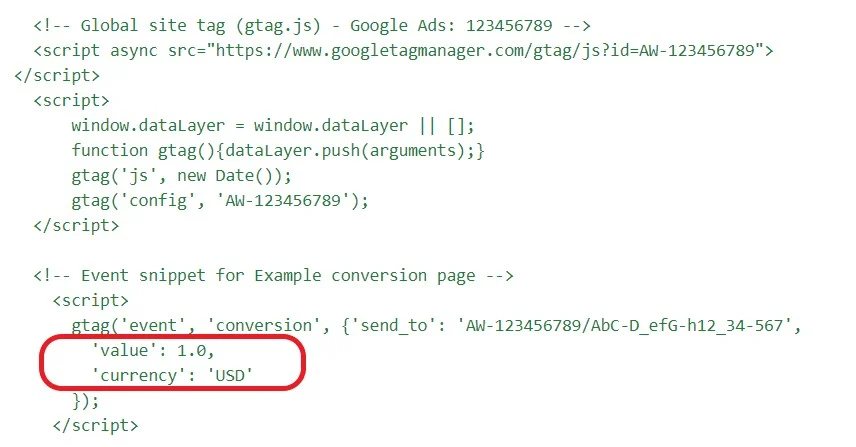In the fast-evolving world of digital advertising, success depends on more than just generating conversions—it’s about the value of each conversion. Value-based bidding with a target ROAS (Return on Ad Spend) has become a powerful tool for businesses aiming to optimise their advertising strategies and maximise their return on investment.
Traditionally favoured by e-commerce businesses to track online sales within Google Ads, value-based bidding with target ROAS is increasingly being adopted by service providers seeking to generate high-value leads that drive profitable sales growth.
For service companies, integrating CRM data with Google Ads offline conversion tracking presents a new opportunity. By importing revenue data from leads generated by Google Ads that convert into customers, these businesses can measure the direct financial impact of their advertising efforts more accurately within Google Ads. This approach enhances campaign measurement by optimising for revenue rather than a fixed cost per lead (CPA).
This capability allows for more precise revenue and profit calculations, aligning ad spend with actual business goals and providing a clearer view of advertising effectiveness to support more strategic budget allocation.
What is Value-Based Bidding
Value-based bidding is an advanced Google Ads strategy that optimises bids based on the specific value each conversion brings to a business, rather than treating all conversions equally, as with Target CPA bidding. This approach allows advertisers to assign distinct monetary values to various conversion actions, enabling Google’s algorithm to prioritise higher bids for more valuable outcomes, such as high-revenue purchases or leads with significant lifetime potential.
Unlike Target CPA, where every conversion is assigned the same value, value-based bidding measures and optimises campaigns based on actual financial metrics, such as sales revenue or profit margin. This alignment of ad spend with an advertiser’s financial goals maximises returns by focusing on conversions that contribute most significantly to business growth.
By assigning specific values to different conversion types, value-based bidding (VBB) enables businesses to prioritise high-quality leads or high-value sales, boosting return on ad spend (ROAS) and overall profitability. This approach allows companies to focus on lead quality over quantity, enhancing the financial outcomes of each campaign.
With this targeted strategy, every pound spent is strategically aligned with revenue objectives, maximising the financial gains from each campaign. In this article, we’ll explore the mechanics of value-based bidding, examine its benefits, and discuss how it enables both e-commerce and service-based companies to achieve revenue-driven ad optimisation.

Go Beyond CPA Bidding (Cost Per Lead) with VBB Bidding
In digital advertising, it’s clear that not all leads are created equal. Traditional Cost Per Acquisition (CPA) bidding has been a reliable way to control acquisition costs, but it applies the same cost target to every lead. This standardised approach falls short for businesses where different conversions contribute varying levels of value—why pay the same for a low-value lead as you would for a high-revenue client?
Value-based bidding refines ad optimisation by aligning spending with the financial impact each lead or conversion brings to the business. Instead of aiming for a set cost per conversion, advertisers can assign unique values to different types of conversions. For example, a lead representing a high-value purchase or a customer with strong lifetime potential is far more valuable than a general enquiry. By using Google’s value-based bidding, you can prioritise bids for these higher-value leads, ensuring that your ad spend directly supports financial objectives and maximises return on ad spend (ROAS).
Key Steps in Transitioning from CPA to Value-Based Bidding:
Assigning Conversion Values: Define the monetary value of different conversions based on their business impact. Integrating systems like CRMs, POS platforms, or payment processors (such as Stripe) with Google Ads allows you to automatically import real revenue data, updating conversion values accurately and consistently.
Implementing Smart Bidding Strategies: Adopt automated strategies such as Maximise Conversion Value or Target Return on Ad Spend (tROAS). These tools dynamically adjust bids in real-time to maximise total conversion value within your budget, directing spending towards high-value conversions.
Continuous Monitoring and Adjustment: Regularly review performance data to gain insights and spot trends. Adjust bids and strategies accordingly, ensuring that each lead acquisition aligns with your business goals and that your budget is used effectively.
Shifting from a one-size-fits-all model to a value-focused bidding strategy allows advertisers to direct their budgets towards the most profitable outcomes. Value-based bidding lets you focus on high-quality, high-value leads, boosting profitability and providing a competitive edge in the digital marketplace. This approach ensures every pound spent works to drive the maximum contribution to business growth, moving beyond the limitations of paying a uniform amount for every lead.

The Origins Backstory of Value-based Bidding
Originally, value-based bidding was primarily employed by e-commerce businesses that tracked revenue by importing the sales value directly from their e-commerce checkout receipt pages into Google Ads. .
Tracking sales revenue provided retail e-commerce companies with a significant advantage in reporting and measurement compared to service-based businesses focused on lead generation. Lead-generation accounts were constrained to using target CPA bidding, treating all leads as equal in value with a standardised cost per lead and average lead value, lacking the nuanced optimisation capabilities accessible to e-commerce.
Today, it’s easier than ever to connect various systems—such as CRM platforms, POS systems, or payment processors like Stripe, which can integrate with online quoting tools—directly with Google Ads. This integration now enables advertisers to pull offline sales conversion data from their CRM back into Google Ads, allowing them to optimise campaigns using value-based bidding based on real sales data. This evolution has made value-based bidding accessible to a broader range of industries, enabling more precise, revenue-focused ad management.
How Value Bidding Works
- Setting Conversion Values: Advertisers assign monetary values to different types of conversions based on their importance to the business, or preferably setup and automated import of sales revenue directly from a CRM, POS or payment processor like Stripe into Google Ads.
- Maximise Conversion Value (+target ROAS) Bid Strategy: Automated bidding strategies like Maximise Conversion Value to adjust bids automatically, aiming to maximise the total conversion value within the set budget.
- Data Feedback: Accurate conversion data, including the value of each conversion, is fed back to Google Ads to help the algorithm optimise bids effectively.

Value-Based Bidding Strategies
Google Ads previously offered two main value-based bidding strategies, but they are now consolidating these options by allowing a Target ROAS setting within the Maximise Conversion Value bid strategy.
Maximise Conversion Value: When used without a Target ROAS, this strategy aims to spend the daily budget while maximising total sales revenue. Bids are adjusted up or down to ensure spending aligns closely with the set daily budget, prioritising conversions that offer the highest revenue within that budget.
Target ROAS (tROAS): By setting a Target ROAS within the Maximise Conversion Value strategy, advertisers can control bids to achieve a specific return on ad spend. If the target ROAS isn’t met, bids are automatically reduced, acting as a cost control mechanism beyond the daily budget. This approach balances revenue maximisation with the need to meet profitability targets, providing an added layer of efficiency and financial oversight.

Benefits of Value-Based Bidding
Value-based bidding offers several advantages for advertisers aiming to optimise their digital marketing efforts:
Maximised Revenue: By focusing on high-value conversions, advertisers can enhance revenue generation from their ad spend.
Efficient Budget Utilisation: This approach ensures that advertising spend is directed towards actions that most significantly impact the bottom line, reducing waste on lower-value conversions.
Competitive Edge: Adopting value-based bidding provides an advantage over competitors who have not implemented this approach.
Quality Over Quantity: The emphasis shifts from merely increasing the number of conversions to securing those that offer the most value to the business.
Enhanced Return on Investment (ROI): Prioritising high-value conversions allows businesses to allocate advertising budgets more effectively, leading to improved ROI.
Improved Customer Acquisition: Targeting valuable conversions helps attract and retain customers who are likely to contribute significantly to the business’s success.
Optimised Campaign Performance: Aligning bids with conversion values facilitates continuous optimisation, as campaigns are adjusted based on real-time data to maximise overall value.
Enhanced Reporting and Measurement: Implementing value-based bidding provides more detailed insights into the performance of various conversion actions, enabling advertisers to assess the effectiveness of their campaigns with greater precision. This improved measurement facilitates data-driven decision-making and strategic adjustments.
360-Degree Closed-Loop Reporting: Integrating value-based bidding with closed-loop reporting systems allows for comprehensive tracking of customer interactions from initial engagement to final conversion. This holistic view ensures that marketing and sales efforts are aligned, providing a complete understanding of the customer journey and the impact of advertising initiatives.
By adopting value-based bidding, businesses can align their advertising strategies with financial objectives, leading to more efficient use of advertising budgets and improved overall performance.

Best Practices for Value-Based Bidding
- Accurate Value Assignment: Ensure that the values assigned to different conversion actions accurately reflect their importance to your business.
- Regular Monitoring: Continuously monitor and adjust your strategy based on performance data and insights.
- Sufficient Data: Ensure you have enough conversion data for the algorithm to work effectively. Google recommends at least 30 conversions in the past 30 days.
- Budget Flexibility: Keep your budgets sufficiently high to allow the algorithm room to optimise.
- Patience: Allow time for the algorithm to learn and optimise. Avoid making frequent changes that could disrupt the learning process.
- Use of Micro-Conversions: Consider assigning values to micro-conversions (e.g., newsletter sign-ups, video views) to provide more data points for the algorithm.
What Values Should I Measure?
When determining conversion values for Google Ads value-based bidding, consider the following guidelines:
Assigning Accurate Values
Online sales values: For e-commerce transactions, use the actual revenue generated from each sale.
Offline sales values: For service based companies with offline sales or e-commerce companies that sell both online and offline. Use the revenue from a CRM, POS or Stripe
Estimated lifetime value: Measure the lifetime value of each customer to score customers based on high to low value customers.
Profit margins: Consider using profit rather than revenue to account for your costs.
Micro-conversions: Assign smaller values to actions like newsletter sign-ups or content downloads based on their estimated worth to your business.
Static vs Dynamic Values
Static values: Don’t use static values if you are able to import dynamic values,
Static values can be used for conversions that consistently have the same value, like a fixed-price product or service.
Dynamic values: Implement for conversions where the value varies, such as e-commerce purchases with different order totals.
Best Practices
Be realistic: Ensure your assigned values accurately reflect the true worth of each conversion to your business.
Regular review: Periodically reassess and adjust your conversion values based on actual business data and performance.
Test and refine: Start with your best estimates and refine over time as you gather more data.
Consider indirect value: Factor in the potential long-term value of actions like email sign-ups or whitepaper downloads.
Advanced Considerations
Conversion value rules: Use these to adjust values based on factors like audience, location, or device.
Offline conversions: Import offline conversion data to capture the full value of your advertising efforts.
Value adjustments: Implement a system to update conversion values for events like returns or additional purchases.
By carefully assigning and regularly reviewing your conversion values, you can optimise your Google Ads campaigns to focus on driving the most valuable outcomes for your business. Remember, the goal is to provide Google’s algorithms with accurate data to make informed bidding decisions that align with your business objectives.
Setting Up Value-Based Bidding
To implement value-based bidding in your Google Ads account, follow these steps:
- Set Up Conversion Tracking: Ensure proper configuration of conversion tracking in your Google Ads account. This includes online conversion tracking, as well as offline conversion tracking to import sales revenue value. And example script has been included below that is placed on a website for online conversion tracking.
- Assign or Import Conversion Values: The best option here is to setup an automatic import from your CRM, POS or payment processor like Stripe using offline conversion tracking. If you are not able to import offline conversions, then you can using online conversion tracking by going to your conversion settings, assign monetary values to each type of conversion based on its importance to your business goals.
- Choose a Smart Bidding Strategy: Select the value-based bidding strategy “Maximise Conversion Value”. You can set a target ROAS. If you have enough conversion data, Google will suggest a recommended Target ROAS using past sales vs profit results.
- Set Budget and Targets: Determine your daily budget and any additional targets, such as a target ROAS
. - Analyse Performance Data: Regularly review campaign performance data to identify trends and insights.
- Adjust Bids: Use the gathered data to adjust bids based on the actual value of conversions.
- Experiment with Bid Adjustments: Test different bid adjustments based on factors like device type, location, or time of day.

Valued Bidding for e-Commerce
Value-based bidding is an essential strategy for e-commerce businesses that want to optimise for revenue rather than just conversion volume. By focusing on high-value transactions and leveraging detailed insights, e-commerce companies can drive more impactful results from their ad spend, positioning themselves for growth and competitive advantage.
By allowing advertisers to prioritise conversions based on their monetary value, this approach enables e-commerce businesses to focus on driving high-value transactions rather than treating all conversions equally. Here’s how value-based bidding specifically benefits e-commerce campaigns:
Maximised Revenue per Conversion: E-commerce businesses often have varying product prices and profit margins. Value-based bidding enables them to assign higher bids to more profitable product categories or high-value purchases. This ensures that ad spend is concentrated on conversions that drive the most revenue, allowing for efficient budget allocation that aligns with revenue goals.
Improved Return on Ad Spend (ROAS): For e-commerce, ROAS is a critical metric that reflects the profitability of ad campaigns. Setting a Target ROAS within the Maximise Conversion Value strategy helps ensure that the campaign not only maximises conversion value but also meets specific profitability thresholds. This control mechanism prevents overspending on low-value conversions, making campaigns more cost-effective.
Better Control Over Customer Lifetime Value: By assigning values based on potential customer lifetime value (LTV), e-commerce businesses can use value-based bidding to focus on high-LTV customers. This approach encourages repeat purchases and brand loyalty, ensuring that the ad budget targets conversions with long-term revenue potential.
Enhanced Reporting and Insights: Value-based bidding provides more granular insights into which products or product categories are generating the highest returns. This data is invaluable for e-commerce businesses to refine their product offerings and promotional strategies based on real-time performance metrics.
Flexible Integration with E-commerce Platforms: Modern e-commerce platforms make it simple to integrate value-based bidding with tools like Google Ads. By feeding sales data from platforms such as Shopify, WooCommerce, or custom e-commerce solutions directly into Google Ads, businesses can track the actual revenue from each conversion, enabling real-time optimisation for better decision-making.
Value Bidding for Services-based companies
For service companies, value-based bidding enables a shift from quantity to quality in lead generation, ensuring that ad budgets are spent on opportunities with the highest return potential. By aligning ad strategies with revenue goals, service-based businesses can achieve greater efficiency and profitability in their digital marketing efforts.
Value-based bidding can be transformative for service-based companies by enabling them to prioritise leads that are most valuable based on the anticipated revenue or profitability of each lead. Here’s how value-based bidding can elevate advertising strategies for service-based businesses:
Focus on High-Quality Leads: Service companies often encounter leads that differ significantly in quality and potential revenue. Value-based bidding allows them to assign higher bids to leads with greater revenue potential, such as those most likely to progress through lead stages. This approach enables service companies to optimise for leads that are more likely to convert into profitable, long-term clients.
Precision in Budget Allocation: With value-based bidding, service companies can prioritise budget towards channels, demographics, or keywords that yield the most valuable leads. This enables more precise targeting, focusing ad spend on audience segments that are more likely to convert into high-value clients, rather than simply generating high lead volume.
Enhanced Reporting and ROI Measurement: Value-based bidding offers service-based companies richer reporting and more meaningful insights, such as which campaigns or ad groups generate leads with the highest revenue potential. This data allows businesses to continuously refine their targeting, messaging, and overall ad strategy, leading to improved ROI and sustainable growth.
Improved Client Acquisition Costs: By setting values based on factors like projected client lifetime value or expected revenue from specific services, service-based companies can control their client acquisition costs more effectively. When a Target ROAS is used, Google Ads adjusts bids to meet the desired profitability threshold, allowing businesses to minimise costs while maximising high-value lead generation.
Effective Use of CRM and Offline Data: Many service-based businesses use CRM systems to track and qualify leads as they move through the sales pipeline. By integrating CRM data with Google Ads, companies can feed back the value of each lead—based on their likelihood to close or the revenue of closed deals—into the campaign. This integration creates a closed-loop system, where ad spend is continually optimised based on the actual revenue generated, not just the number of leads.
CRM Integration
Integrating your Customer Relationship Management (CRM) system to import sales data into Google Ads can significantly enhance the optimisation of your campaigns for revenue value. This enables the automatic transfer of sales figures from your CRM into Google Ads, allowing you to tailor its bidding strategies based on actual revenue generated from transactions. By leveraging real-time and accurate sales data, you can fine-tune your value-based bidding strategies, ensuring that your advertising budget is concentrated on those conversions that deliver the highest financial returns. This approach not only improves the efficiency of your ad spend but will increase high-value sales as well. To learn more see our guide: Google Ads CRM Integration.

POS (e.g. Stripe) Integration with Google Ads
Integrating your Point of Sale (POS) system, such as Stripe, to import transaction data into Google Ads can significantly enhance the optimisation of your campaigns for revenue value. This integration enables the automatic transfer of precise transaction figures from Stripe into Google Ads, allowing the platform to adjust its bidding strategies based on the actual revenue generated from completed sales. By leveraging real-time and accurate sales data, you can fine-tune your value-based bidding strategies, ensuring that your advertising budget is concentrated on those conversions that deliver the highest financial returns. This approach not only improves the efficiency of your ad spend but also ensures that your marketing efforts are consistently aligned with the most profitable aspects of your business. To learn more, see our guide: How to Integrate Google Ads with Stripe.

Summary
Value-based bidding transforms digital advertising from a numbers game into a profitability-focused strategy. By prioritising high-value conversions, businesses can ensure that their advertising spend directly supports their financial goals and maximises return on ad spend (ROAS).
This approach offers valuable insights, optimised customer acquisition, and enhanced reporting capabilities, empowering advertisers to make informed, data-driven decisions. Whether you’re in e-commerce or a service industry, implementing value-based bidding provides a refined, ROI-driven strategy that improves both the efficiency and impact of your Google Ads campaigns.
Value-based bidding in Google Ads represents a sophisticated method for optimising ad performance by focusing on the true value each conversion contributes to your business. By aligning your bidding strategy with financial objectives and continually monitoring and adjusting based on performance data, you can drive significant growth and ensure your ad spend is allocated effectively.
Embracing value-based bidding could be the key to unlocking sustained growth and a competitive edge in your digital marketing efforts.
Successful implementation of value-based bidding requires a deep understanding of your conversion values, regular monitoring, and patience as the algorithm learns and optimises. With a thoughtful approach, value-based bidding can be a transformative tool for your Google Ads campaigns, helping you achieve your advertising goals and secure long-term success.